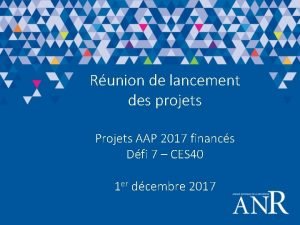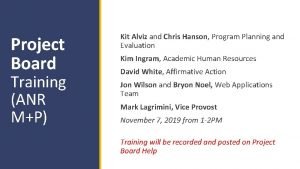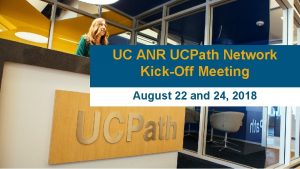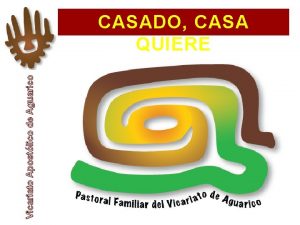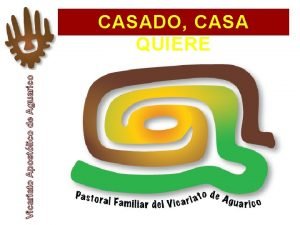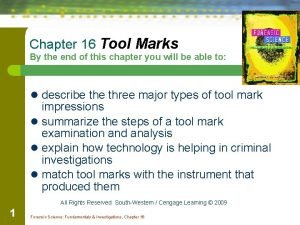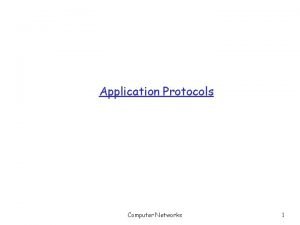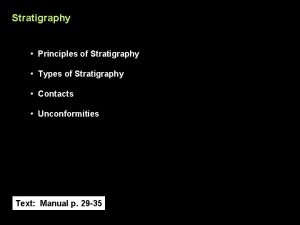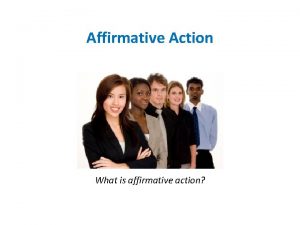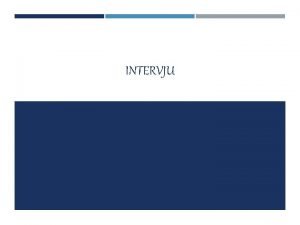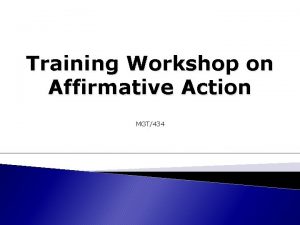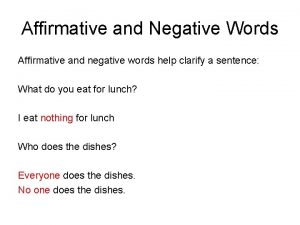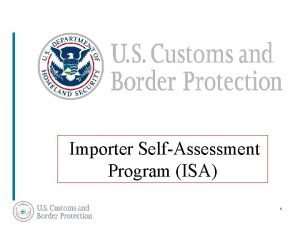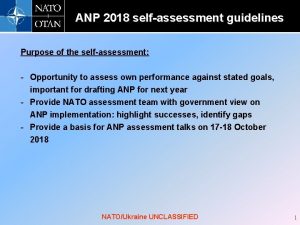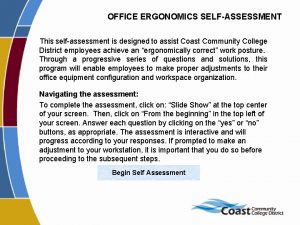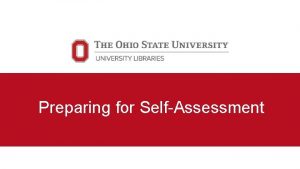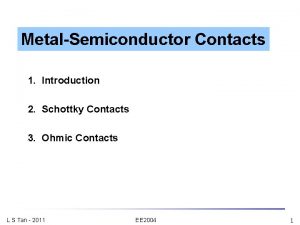Introduction to CASA Contacts And SelfAssessment ANR Affirmative





















- Slides: 21

Introduction to CASA (Contacts And Self-Assessment) ANR Affirmative Action Office

Topics & Outcomes Participants will have an understanding of. . . • What is Affirmative Action? • What is CASA? • CASA Nuts & Bolts Why do we collect racial data? What is All Reasonable Effort? What is parity of participation? 4 H/NFCS Programs and CASA • What is Program Compliance?

Overview of Affirmative Action • First established by the federal government in 1965 through an executive order signed by President Lyndon Johnson • Designed to eliminate the present effects of past discrimination, such as the under-representation of minorities and women; and, in addition, to encourage the employment of veterans and persons with disabilities. • Valuing inclusion and diversity to guide educational programming for our clientele. • Implement the ANR Core Values as an expression of support for the goals of Affirmative Action.

What is CASA? The following USDA requirement receives its scope, in part, from Code of Federal Regulations, Title 7: Agriculture, Subtitle A: Office of the Secretary of Agriculture, Part 15 A “Each agency that administers programs subject to 7 CFR 15, Subpart A or B, will develop a system for establishing base data that identifies eligible populations and measures delivery of program benefits in order that the quantity and quality of benefits and services delivered to minority individuals can be documented and compared to benefits delivered to nonminority individuals. . . ” Ultimately, CASA is to be documentation that ANR executes its CE mission with equality. . . that the “quantity and quality of benefits and services” is the same for both people of color and whites.

CASA Nuts & Bolts

Why Do We Have to Collect Racial Data? v California courts have held that use of racial data to monitor for non-discrimination does NOT violate Proposition 209 (which doesn’t apply to us anyway). v In order to comply with the USDA requirement that the “. . . quantity and quality of benefits and services delivered to minority individuals can be documented and compared to benefits delivered to nonminority individuals. . . ”

Why Do We Report Contacts? • Compliance with Federal and State Civil Rights Laws • Promote nondiscrimination and the valuing of differences among clientele • To move toward program compliance What is Program Compliance? Program Compliance or compliance with federal requirements is achieved when 1) clientele contacts are in “Parity”; but if parity is not achieved, then 2) through establishing All Reasonable Effort (more on this later).

What is Parity? Parity or ‘parity of participation’ is defined by the USDA as when the percentage of each minority group making up your actual contacts comes to within 20% of their percentage in the baseline. For example, if Hispanics make up 10% of your potential or baseline, then Hispanics should make up at least 8% of your actual contacts in order for your program to be in parity for Hispanics. What is All Reasonable Effort? All Reasonable Effort (ARE) is the utilization of at least three of four specific outreach methods (i. e. 1 -Mass Media; 2 -Newsletter/flyers; 3 -Personal letters/emails; 4 -Personal contacts) in order to expand access and move toward or maintain parity of participation.

Your AA Responsibilities… Establishing Your Baseline • Learn about the demographics of your county by viewing US Census, Ag Commissioners Report, CBEDS, local data, and local knowledge • Define potential audience for each program v. Ask who are those individuals who would be interested in or benefit from your educational program • Work with partners and stakeholders who represent and serve those protected classes v. Where they live and work v. Their values and beliefs v. Their cultures.

Your AA Responsibilities • All reasonable efforts to reach individuals who are representative of the cultures and ethnicities, genders and age of your county/area • Move from ARE toward parity in program participation • Partner with groups, agencies and organizations to reach protected audiences you want to reach • Include people from protected or underrepresented groups on program planning committees or groups or survey lists • Keep mailing and e-mail lists • Make personal contacts from protected or underrepresented groups • Conduct meetings/trainings in facilities welcoming and accessible.

4 -H & NFCS Programs and CASA • 4 -H Advisors are NOT required to enter club or group Youth enrollments as contacts in CASA. • NFCS Advisors in UC Cal. Fresh or EFNEP who have been entering adult and/or youth participants as contacts in CASA (and are comfortable with their baseline data) may continue to enter their contacts into CASA.

4 -H & NFCS Programs & CASA (cont. ) • NFCS Advisors in UC Cal. Fresh or EFNEP who are not comfortable with their baseline data or a new advisor who has not determined a baseline are NOT required to enter contacts into CASA. The State YFC Office and ANR AA will take your participation data, establish a standardized baseline and determine the compliance status of your program for you. Your county will be notified concerning the compliance status of your program. v The long term goal is to establish consistent baselines between education programs working with families, adults, and youth. This process will take a few webinars discussions and examination of the different baseline sources. • All other NFCS programs DO require their contact numbers to be entered into CASA. • All 4 -H Advisors and NFCS Advisors are required to enter their Outreach into CASA.

4 -H Enrollment (Clientele Contacts) 4 -H Outreach Methods 4 -H Clubs County 4 -H YDP Staff and Advisors Complete Outreach Methods Documentation Form annually Form turned in to UCCE County Office as part of the yearend club reporting Outreach methods entered into CASA Information used to establish ARE Information sent to UC ANR Office of Program Planning and Evaluation 4 -H Individual Enrollment (e. g. , club, camp) (youth and adults) Whereas 4 -H enrollments are recorded in the national 4 h. Online system, 4 -H outreach is not; therefore, it is important to have it recorded in CASA. Information sent to UC ANR AA Office to assess compliance at the state level and in individual county programs 4 -H Group Enrollment (e. g. , school enrichment, afterschool) (youth and adults) Enrollment/ clientele contacts entered into 4 h. Online Information sent to UC ANR Office of Program Planning and Evaluation Information used for statewide program planning

Sample of 4 -H Outreach form that every 4 -H club is required to fill out and submit to the county 4 -H Office. The four specified Outreach Methods. You must use 3 of these first 4 to establish All Reason -able Effort (ARE).

4 -H & NFCS Programs & CASA (cont. ) (again) Community Education Specialists formally known as “Program Representatives” • • Community Education Specialists in Cal. Fresh or EFNEP who do not have a NFCS Advisor supervising the program in their county/area should consult with their County/ Area Director. CE program activity needs to be recorded in CASA. At the discretion of the County/Area Director, the Community Education Specialist can be provided CASA access to enter their programmatic activity into CASA – either that or some other advisor with CASA access will need to enter the programmatic activity into CASA for them. Whoever enters the Cal. Fresh or EFNEP data into CASA, they are not required to enter the contact data into CASA if. . . 1) The Community Education Specialist responsible for the program is not comfortable with the existing baseline data, or. . . 2) No baseline data has yet been established. • The State YFC Office and ANR AA will take your participation data, establish a standardized baseline and determine the compliance status of your program for you.

4 -H & NFCS Programs & CASA (cont. ) (again) Community Education Specialists formally known as “Program Representatives” • Community Education Specialists in all other NFCS programs are required to enter their contact numbers into CASA (or have someone else with CASA access enter them for them). • No matter what the program, all Outreach is required to be entered into CASA.

What is Outreach? Why Do We Do It? • • Outreach is the things you do to encourage people to participate in your program. It is not synonymous with program delivery methods. Outreach can be targeted to reach underserved clientele in order to expand access. • Promote nondiscrimination and the valuing of differences among clientele. • To promote the widest adoption of best practices to the widest possible audience.

Evaluation County Director/MCP Director annually complete the CASA County/MCP Director report in CASA. Measurable Goals: establish measurable goals such as moving toward full parity in your program. AA Office annually reviews CASA reports and monitors progress toward compliance/parity. Also, supplies compliance status of programs of advisors up for Merit/ Promotion to Executive Director of Academic Personnel. Advisors should be comfortable defending their choice of clientele group(s) and the source of their baseline data should there be a federal audit.

The End Almost.

TEST TIME! Were YOU Paying Attention? What is Parity? What is All Reasonable Effort? How is compliance achieved? What is Outreach?

Questions? Contact. . . David White dewhite@ucanr. edu 530 -750 -1286
 Reglement financier anr
Reglement financier anr Anr story
Anr story Anr kit
Anr kit Anr asociativos fontar
Anr asociativos fontar Uc anr portal
Uc anr portal Anr monitoring
Anr monitoring Casados casa quieren
Casados casa quieren Y los dos serán una sola carne
Y los dos serán una sola carne Qasim and yahya limited contacts
Qasim and yahya limited contacts Yomi name google contacts
Yomi name google contacts Qing qing hardware contacts
Qing qing hardware contacts China limits european contacts
China limits european contacts Tool marks evidence
Tool marks evidence Mustafa shakir contacts
Mustafa shakir contacts Ftp protocol in computer networks
Ftp protocol in computer networks Years of goodbye chapter 9
Years of goodbye chapter 9 Stratigraphic contacts
Stratigraphic contacts Professor atinga
Professor atinga Contacts focaux
Contacts focaux Mogwase eskom contacts
Mogwase eskom contacts How did hongwu bring stability to china
How did hongwu bring stability to china Fully bilateral balanced occlusion
Fully bilateral balanced occlusion
